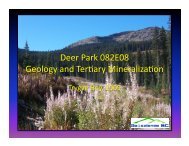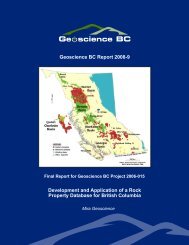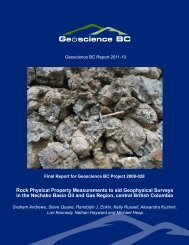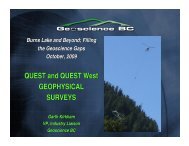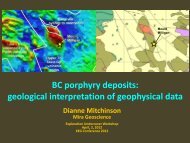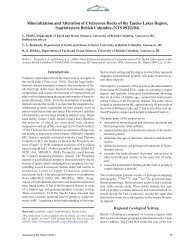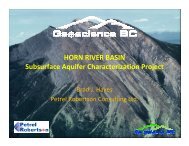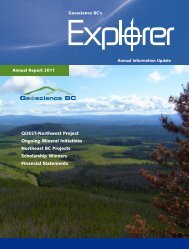Notes Accompanying Original Release of Maps - Geoscience BC
Notes Accompanying Original Release of Maps - Geoscience BC
Notes Accompanying Original Release of Maps - Geoscience BC
- No tags were found...
You also want an ePaper? Increase the reach of your titles
YUMPU automatically turns print PDFs into web optimized ePapers that Google loves.
Metallogenesis <strong>of</strong> the Iskut River Area, Northwestern B.C. --- Regional maps, Lewis<br />
by Grove (1986), and felsic rocks to the Mount<br />
Dilworth Formation. Much <strong>of</strong> the difficulty in working<br />
with this part <strong>of</strong> the section stems from the poor<br />
stratigraphic continuity <strong>of</strong> lith<strong>of</strong>acies, and the lack <strong>of</strong><br />
regional definitions <strong>of</strong> the formations. For example,<br />
the age <strong>of</strong> the Mount Dilworth Formation in its type<br />
area is largely unconstrained, and the type “area” for<br />
the Unuk River Formation is now known to contain a<br />
wide variety <strong>of</strong> rock types representing several<br />
formations.<br />
We assign the entire volcanic and volcaniclastic<br />
sequence from the Jack Formation to a distinct shift<br />
in style <strong>of</strong> volcanism in the lower Middle Jurassic to<br />
the Betty Creek Formation. This formation<br />
encompasses most <strong>of</strong> the rocks previously assigned<br />
to the Betty Creek and Unuk River formations, as<br />
well as some rocks previously assigned to the Mount<br />
Dilworth formation. Use <strong>of</strong> the Unuk River Formation<br />
is discontinued due to its poorly constrained definition.<br />
Within the Betty Creek Formation, three members are<br />
defined. The Unuk River Member comprises andesitic<br />
composition volcanic and volcaniclastic strata, similar<br />
to the rock types included within the original definition<br />
<strong>of</strong> the Unuk River Formation by Grove (1986). The<br />
Brucejack Lake Member <strong>of</strong> the Betty Creek<br />
Formation consists <strong>of</strong> andesitic to dacitic pyroclastic,<br />
epiclastic, and flow rocks which stratigraphically<br />
succeed and may be in part laterally equivalent to parts<br />
<strong>of</strong> the Unuk River Member. The Unuk River and<br />
Brucejack Lake Members are overlain by marine<br />
sedimentary rocks <strong>of</strong> the Treaty Ridge Member.<br />
Unuk River Member: Andesitic flows.<br />
breccias, and volcaniclastic rocks<br />
Andesitic composition flows, volcanic breccias,<br />
and related epiclastic rocks overlying the Jack<br />
Formation are included within the Unuk River Member<br />
<strong>of</strong> the Betty Creek Formation. The Unuk River<br />
Member is well exposed throughout the eastern Iskut<br />
River area, with thickest, best exposed sections at<br />
Eskay Creek, Johnny Mountain, Treaty Creek, and<br />
Salmon Glacier. The thickness <strong>of</strong> the Unuk River<br />
Member varies substantially: coarse volcanic breccias<br />
locally form accumulations up to 2 km thick; these<br />
localized deposits may pinch out completely in<br />
distances <strong>of</strong> less than 5 km.<br />
Lithology:<br />
The thickest and best preserved sections <strong>of</strong> the<br />
Unuk River Member are near Treaty Creek and in<br />
the Sulphurets area. In these locations, hornblende +<br />
plagioclase-phyric andesitic to dacitic flows and dark<br />
green volcanic breccias are intercalated with lapilli to<br />
block tuff, and lesser amounts <strong>of</strong> epiclastic sandstone<br />
and wacke. Volcanic breccias are monolithologic to<br />
slightly polylithic, commonly contain vesicular clasts,<br />
and have a plagioclase-rich volcanic matrix. At Salmon<br />
Glacier, two distinct members are differentiable: a<br />
lower porphyritic andesitic volcanic breccia to block<br />
tuff (Unuk River formation <strong>of</strong> Alldrick, 1991),<br />
separated by plagioclase-hornblende-potassium<br />
feldspar megacrystic flows or sills from an upper,<br />
maroon, well bedded epiclastic conglomerate to<br />
sandstone member (Betty Creek Formation <strong>of</strong><br />
Alldrick, 1991).<br />
Contact Relationships:<br />
The Unuk River Member conformably overlies<br />
the Jack Formation in sections exposed at Eskay<br />
Creek, John Peaks, Salmon Glacier, and Treaty Glacier.<br />
At Johnny Mountain, the Unuk River Member forms<br />
the lowermost unit <strong>of</strong> the Hazelton Group and<br />
unconformably overlies the Triassic Stuhini Group. The<br />
upper contact is defined as a transition to either<br />
epiclastic dacitic rocks <strong>of</strong> the Brucejack Lake<br />
Member, or to marine sedimentary rocks <strong>of</strong> the Treaty<br />
Ridge Member.<br />
Age:<br />
The age <strong>of</strong> the Unuk River Member is<br />
constrained by fossils collected from bounding units,<br />
and by isotopic dating <strong>of</strong> volcanic flows at Johnny<br />
Mountain. An older limit <strong>of</strong> Upper Hettangian to<br />
Lower Sinemurian is provided by fossil collections<br />
from the underlying Jack Formation (described above).<br />
Treaty Ridge Member strata overlying the Unuk River<br />
Member at Eskay Creek and near John Peaks contain<br />
Upper Pliensbachian ammonites, bracketing the age<br />
<strong>of</strong> the former to Sinemurian or Pliensbachian.<br />
U-Pb zircon dates at Johnny Mountain<br />
corroborate this timing: Plagioclase-phyric dykes<br />
cutting dacite to andesite Unuk River Member flows<br />
have a U-Pb zircon age <strong>of</strong> 192 ± 3 Ma, while samples<br />
from the unit itself yield U-Pb zircon ages <strong>of</strong> 193 ±<br />
Ma. Overlying felsic tuffs, correlated with the<br />
Brucejack Lake Member, provide a further bracketing<br />
constraint <strong>of</strong> 194 ± 3 Ma (M.L. Bevier, pers. comm.,<br />
1994).<br />
Brucejack Lake Member: Felsic pyroclastic<br />
rocks and rhyolite flows<br />
Dacitic to rhyolitic pyroclastic rocks, epiclastic<br />
79





